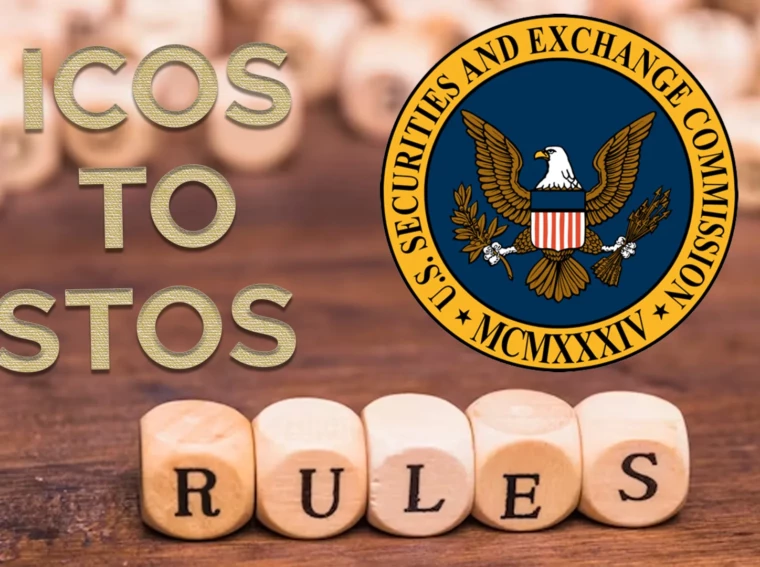- Securities and Exchange Commission applied the Howey Test to assess whether a token qualifies as a security.
- SEC aims to safeguard investors against dubious or fraudulent token offers.
- Both ICOs and STOs aim to raise substantial amounts of outside capital.
An innovative method called a token offering allows businesses to raise money by selling tokens to outside investors. Tokens are distributed ledger technology (DLT)–based digital assets that are cryptographically secured, whereas blockchain technology is the most common kind of DLT. Initial token offerings (ICOs) and security token offerings (STOs) can be distinguished based on the type of token that is issued in the token offering.
Security tokens are issued in the security token offering, whereas utility and currency tokens are issued in the initial coin offering. STOs are subject to significantly stronger securities requirements than other methods, hence they are less regulated overall.
Token economy affected by SEC regulations
- ICOs and regulatory issues
During the ICO boom, many token sales were carried out without regulatory oversight, raising issues with investor protection and possible violations of securities laws. The SEC expressed the opinion that some coins provided in ICOs would qualify as securities and fall under the jurisdiction of federal securities laws.
- Howey test and securities classification
To assess whether a token qualifies as a security, the SEC applies the Howey test, which was developed from a Supreme Court judgment. The Howey test states that a token is a security if it entails a financial investment in a group venture with the prospect of benefits derived mostly from the labor of others. If a token fits these requirements, it is governed by securities laws.
- Enforcement measures
The SEC has taken enforcement measures against several initial coin offerings (ICOs) that it believed to have broken securities laws. These included levying penalties, asking token issuers to register their tokens as securities, or directing investors to receive their money back. These steps made it quite obvious that non-compliant token offers would be subject to regulatory repercussions.
- Compliance with STOs
STOs are a concept that evolved in reaction to regulatory scrutiny. With the use of STOs, tokens that are compliant with securities laws are issued, giving investors legal protection. Issuers can provide tokenized securities that adhere to existing norms and comply with securities legislation by conducting STOs.
- Protection of investors and regulation
By participating in the token economy, the SEC hopes to safeguard investors against dubious or fraudulent token offers. The SEC works to ensure that issuers adhere to legal obligations and that investors have access to accurate and comprehensive information about the tokens they invest in by enforcing laws.
- Legislative advice
To assist market participants in navigating the regulatory environment, the SEC has given guidance. Token classification, registration requirements, and compliance obligations are just a few of the issues it has addressed in several pronouncements, reports, and alerts. This advice helps investors, exchanges, and token issuers understand and abide by securities laws.
- Impact on Innovation and Tokenization
The laws and enforcement actions of the SEC have had an impact on the growth of the token economy. Projects are taking into account compliant tokenization techniques, investigating alternative fundraising strategies like STOs, and looking for regulatory clarification as a result of the focus on securities rules. Compliance may increase complexity and expenses while also fostering investor confidence and broader use of tokenized assets.
Difference between ICO and STO
Investors are becoming more and more interested in ICOs and STOs. A key factor in this is that both techniques enable companies to raise substantial amounts of outside capital with minimal transaction costs.
Although a company might theoretically launch an ICO at any stage of development, most companies do it in the beginning. STOs, in contrast, are conducted independently of the firm’s level of development. IPOs are carried out at an advanced stage since they are used to provide existing businesses with high-volume expansion capital
ICOs are more concerned with firm fundraising, whereas STOs are made to finance a company. As a result, the right-hand side of the balance sheet (equity or long-term obligations) of the issuing firm is impacted by capital raised through STOs. In contrast, the income statement (revenue) of the issuing company is impacted by cash raised through an ICO. However, money obtained through ICOs could also be seen as a temporary obligation.
ICOs in this instance are a type of working capital financing that has an impact on the right side of the balance sheet. Both token sale techniques aim to raise money, although they differ in this way.
Conclusion
The SEC’s laws have had a huge impact on the token economy, but other regulatory agencies around the world have also actively shaped the regulatory environment for token sales. It is vital to keep in mind that regulations differ among jurisdictions. Market players must adhere to applicable securities legislation to navigate the developing token economy and keep up with regulatory compliance.

